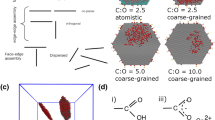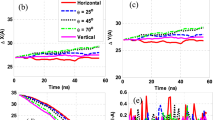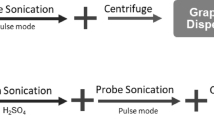Abstract
Dispersing graphite in water to obtain true (single-layer) graphene in bulk quantity in a liquid has been an unreachable goal for materials scientists in the past decade. Similarly, a diagnostic tool to identify solubilized graphene in situ has been long awaited. Here we show that homogeneous stable dispersions of single-layer graphene (SLG) in water can be obtained by mixing graphenide (negatively charged graphene) solutions in tetrahydrofuran with degassed water and evaporating the organic solvent. In situ Raman spectroscopy of these aqueous dispersions shows all the expected characteristics of SLG. Transmission electron and atomic force microscopies on deposits confirm the single-layer character. The resulting additive-free stable water dispersions contain 400 m2 l–1 of developed graphene surface. Films prepared from these dispersions exhibit a conductivity of up to 32 kS m–1.
This is a preview of subscription content, access via your institution
Access options
Subscribe to this journal
Receive 12 print issues and online access
$259.00 per year
only $21.58 per issue
Buy this article
- Purchase on Springer Link
- Instant access to full article PDF
Prices may be subject to local taxes which are calculated during checkout




Similar content being viewed by others
References
Israelachvili, J. N. Intermolecular and Surface Forces (Academic, 2011).
Chandler, D. Interfaces and the driving force of hydrophobic assembly. Nature 437, 640–647 (2005).
Tabor, R. F., Wu, C., Grieser, F., Dagastine, R. R. & Chan, D. Y. C. Measurement of the hydrophobic force in a soft matter system. J. Phys. Chem. Lett. 4, 3872–3877 (2013).
Bonaccorso, F. et al. Graphene, related two-dimensional crystals, and hybrid systems for energy conversion and storage. Science 347, 1246501 (2015).
Cravotto, G. & Cintas, P. Sonication-assisted fabrication and post-synthetic modifications of graphene-like materials. Chem. Eur. J. 16, 5246–5259 (2010).
Paton, K. R. et al. Scalable production of large quantities of defect-free few-layer graphene by shear exfoliation in liquids. Nat. Mater. 13, 624–630 (2014).
He, P. et al. Processable aqueous dispersions of graphene stabilized by graphene quantum dots. Chem. Mater. 27, 218–226 (2015).
Ciesielski, A. & Samorì, P. Graphene via sonication assisted liquid-phase exfoliation. Chem. Soc. Rev. 43, 381–398 (2014).
Lotya, M., King, P. J., Khan, U., De, S. & Coleman, J. N. High-concentration, surfactant-stabilized graphene dispersions. ACS Nano 4, 3155–3162 (2010).
Pénicaud, A. & Drummond, C. Deconstructing graphite: graphenide solutions. Acc. Chem. Res. 46, 129–137 (2013).
Milner, E. M. et al. Structure and morphology of charged graphene platelets in solution by small-angle neutron scattering. J. Am. Chem. Soc. 134, 8302–8305 (2012).
Catheline, A. et al. Solutions of fully exfoliated individual graphene flakes in low boiling point solvents. Soft Matter 8, 7882 (2012).
Englert, J. M. et al. Functionalization of graphene by electrophilic alkylation of reduced graphite. Chem. Commun. 48, 5025–5027 (2012).
Huang, K. et al. Single layer nano graphene platelets derived from graphite nanofibres. Nanoscale 8, 8810–8818 (2016).
Pashley, R. M. Effect of degassing on the formation and stability of surfactant-free emulsions and fine Teflon dispersions. J. Phys. Chem. B 107, 1714–1720 (2003).
Carruthers, J. C. The electrophoresis of certain hydrocarbons and their simple derivatives as a function of pH. Trans. Faraday Soc. 34, 300–307 (1938).
Zimmermann, R., Freudenberg, U., Schweiß, R., Küttner, D. & Werner, C. Hydroxide and hydronium ion adsorption—a survey. Curr. Opin. Colloid Interface Sci. 15, 196–202 (2010).
Siretanu, I., Chapel, J.-P., Bastos-González, D. & Drummond, C. Ions-induced nanostructuration: effect of specific ionic adsorption on hydrophobic polymer surfaces. J. Phys. Chem. B 117, 6814–6822 (2013).
Noah-Vanhoucke, J. & Geissler, P. L. On the fluctuations that drive small ions toward, and away from, interfaces between polar liquids and their vapors. Proc. Natl Acad. Sci. USA 106, 15125–15130 (2009).
Kudin, K. N. & Car, R. Why are water–hydrophobic interfaces charged? J. Am. Chem. Soc. 130, 3915–3919 (2008).
Gray-Weale, A. & Beattie, J. K. An explanation for the charge on water's surface. Phys. Chem. Chem. Phys. 11, 10994–11005 (2009).
Ferrari, A. C. & Basko, D. M. Raman spectroscopy as a versatile tool for studying the properties of graphene. Nat. Nanotech. 8, 235–246 (2013).
Malard, L. M. M., Pimenta, M. A. A., Dresselhaus, G. & Dresselhaus, M. S. S. Raman spectroscopy in graphene. Phys. Rep. 473, 51–87 (2009).
Wang, Y. Y. et al. Raman studies of monolayer graphene: the substrate effect. J. Phys. Chem. C 112, 10637–10640 (2008).
Berciaud, S., Ryu, S., Brus, L. E. & Heinz, T. F. Probing the intrinsic properties of exfoliated graphene: Raman spectroscopy of free-standing monolayers. Nano Lett. 9, 346–352 (2009).
Ma, X., Zachariah, M. R. & Zangmeister, C. D. Crumpled nanopaper from graphene oxide. Nano Lett. 12, 486–489 (2012).
Considine, R. F., Hayes, R. A. & Horn, R. G. Forces measured between latex spheres in aqueous electrolyte: non-DLVO behavior and sensitivity to dissolved gas. Langmuir 15, 1657–1659 (1999).
Meyer, E. E., Rosenberg, K. J. & Israelachvili, J. Recent progress in understanding hydrophobic interactions. Proc. Natl Acad. Sci. USA 103, 15739–15746 (2006).
Parsegian, V. A. Van der Waals Forces: A Handbook for Biologists, Chemists, Engineers, and Physicists (Cambridge Univ. Press, 2005).
Kovtyukhova, N. I. et al. Non-oxidative intercalation and exfoliation of graphite by Brønsted acids. Nat. Chem. 6, 957–963 (2014).
Mary, R., Brown, G., Beecher, S. & Torrisi, F. 1.5 GHz picosecond pulse generation from a monolithic waveguide laser with a graphene-film saturable output coupler. Opt. Express 21, 7943–7950 (2013).
Cançado, L. G. et al. Quantifying defects in graphene via Raman spectroscopy at different excitation energies. Nano Lett. 11, 3190–3196 (2011).
Schäfer, R. A. et al. On the way to graphane-pronounced fluorescence of polyhydrogenated graphene. Angew. Chem. Int. Ed. 52, 754–757 (2013).
Zhao, J., Pei, S., Ren, W., Gao, L. & Cheng, H. M. Efficient preparation of large-area graphene oxide sheets for transparent conductive films. ACS Nano 4, 5245–5252 (2010).
Nixon, D. E. & Parry, G. S. Formation and structure of the potassium graphites. J. Phys. D 1, 291–298 (1968).
Hunter, R. J. Foundations of Colloid Science (Oxford Univ. Press, 2001).
Stinchcombe, J., Penicaud, A., Bhyrappa, P., Boyd, P. D. W. & Reed, C. A. Buckminsterfulleride(1–) salts: synthesis, EPR, and the Jahn–Teller distortion of C60−. J. Am. Chem. Soc. 115, 5212–5217 (1993).
Kravets, V. G. et al. Spectroscopic ellipsometry of graphene and an exciton-shifted van Hove peak in absorption. Phys. Rev. B 81, 1–6 (2010).
Acknowledgements
Support from the Agence Nationale de la Recherche (GRAAL) and the Linde Corporation is acknowledged. A.P. thanks Nacional de Grafite (Brazil) for a gift of natural graphite. This work was carried out within the framework of GDR-I 3217 ‘graphene and nanotubes’.
Author information
Authors and Affiliations
Contributions
G.B. prepared and characterized SLGiw. K.H. and C.D. recorded the AFM images. L.O. and V.M. made the TEM analysis. G.B., E.A., A.P. and C.D. planned the experiments, analysed the experimental data and wrote the manuscript.
Corresponding authors
Ethics declarations
Competing interests
The authors declare no competing financial interests.
Supplementary information
Supplementary information
Supplementary information (PDF 6899 kb)
Supplementary movie
Supplementary movie 1 (MOV 32306 kb)
Rights and permissions
About this article
Cite this article
Bepete, G., Anglaret, E., Ortolani, L. et al. Surfactant-free single-layer graphene in water. Nature Chem 9, 347–352 (2017). https://doi.org/10.1038/nchem.2669
Received:
Accepted:
Published:
Issue Date:
DOI: https://doi.org/10.1038/nchem.2669
This article is cited by
-
Impact of probe sonication and sulfuric acid pretreatment on graphene exfoliation in water
Scientific Reports (2023)
-
Research progress of filled-type high-thermal-conductivity flexible polyimide composites: a review
Journal of Materials Science (2023)
-
A Review on Graphene Oxide Two-dimensional Macromolecules: from Single Molecules to Macro-assembly
Chinese Journal of Polymer Science (2021)
-
Advances in green synthesis and applications of graphene
Nano Research (2021)
-
Hydrodynamic slip can align thin nanoplatelets in shear flow
Nature Communications (2020)



